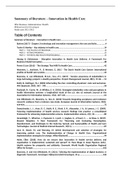Summary of literature – Innovation in Health Care
MSc Business Administration: Health
Rijksuniversiteit Groningen
Study year 2021/2022
Table of Contents
Summary of literature – Innovation in Health Care...........................................................................1
Barlow (2017) - Chapter 2 technology and innovation management: the nuts and bolts..............4
Taylor & Hawley – Key debates in health care.............................................................................14
PART 1 – THE POLITICS OF PROVISION..........................................................................................................16
PART 2 – SETTING PRIORITIES........................................................................................................................25
PART 3 – PATIENTS AND HEALTH PROFESSIONALS.......................................................................................33
Hwang & Christensen - Disruptive Innovation In Health Care Delivery: A Framework For
Business-Model Innovation.........................................................................................................38
Porter & Lee (2013) – The Strategy That Will Fix Health Care......................................................42
Wammes, J., Jeurissen, P., & Westert, G. 2015 - The Dutch Health Care System International
profiles of health care systems....................................................................................................45
Boonstra, A. van Offenbeek, M.A.G., Vos, J.F.J. (2017) - Tension awareness of stakeholders in
large technology projects: a duality perspective. Project Management Journal, 48(1), 19-36.....51
Kohli, R., Kettinger, W.J. (2004) Informating the clan: controlling physicians’ costs and outcomes.
MIS Quarterly, 28(3), 363 – 394...................................................................................................56
Pouloudi, N., Currie, W., & Whitley, E. A. (2016). Entangled stakeholder roles and perceptions in
health information systems: a longitudinal study of the u.k. nhs n3 network. Journal of the
Association for Information Systems, 17(2), 107–161..................................................................61
Van Offenbeek, M., Boonstra, A., Seo, D. (2013) Towards integrating acceptance and resistance
research: evidence from a telecare case study. European Journal of Information Systems, 22(4),
434-454.......................................................................................................................................73
Damschroder, L. J., Aron, D. C., Keith, R. E., Kirsh, S. R., Alexander, J. A., & Lowery, J. C. (2009).
Fostering implementation of health services research findings into practice: a consolidated
framework for advancing implementation science. Implementation science, 4(1), 50................80
Greenhalgh, T., Wherton, J., Papoutsi, C., Lynch, J., Hughes, G., A'Court, C., ... & Shaw, S. (2017).
Beyond Adoption: A New Framework for Theorizing and Evaluating Nonadoption,
Abandonment, and Challenges to the Scale-Up, Spread, and Sustainability of Health and Care
Technologies. Journal of Medical Internet Research, 19(11)........................................................87
Grol, R., Bosch, M. and Wensing, M. (2013) Development and selection of strategies for
improving patient care. The Implementation of Change in Health Care. Organizational
implementation strategies for change. Wiley-Blackwell..............................................................94
Nolte, Ellen (2018). How do we ensure that innovation in health service delivery and
organization is implemented, sustained and spread? In: Hans Kluge & Josep Figueras (eds.),
Health systems for prosperity and solidarity. Denmark: World Health Organization Regional
Office for Europe.......................................................................................................................102
Boonstra, A. and Van Offenbeek, M. (2021). Tailoring the implementation of digital business: A
diagnostic framework. Groningen: Rijksuniversiteit Groningen. 25 p........................................106
, Barlow (2017) - Chapter 2 technology and innovation management: the nuts and bolts...................3
Taylor & Hawley – Key debates in health care................................................................................13
Hwang & Christensen - Disruptive Innovation In Health Care Delivery: A Framework For
Business-Model Innovation.............................................................................................................37
Porter & Lee (2013) – The Strategy That Will Fix Health Care.......................................................41
Wammes, J., Jeurissen, P., & Westert, G. 2015 - The Dutch Health Care System International
profiles of health care systems.........................................................................................................44
Boonstra, A. van Offenbeek, M.A.G., Vos, J.F.J. (2017) - Tension awareness of stakeholders in
large technology projects: a duality perspective. Project Management Journal, 48(1), 19-36.........50
Kohli, R., Kettinger, W.J. (2004) Informating the clan: controlling physicians’ costs and outcomes.
MIS Quarterly, 28(3), 363 – 394......................................................................................................55
Pouloudi, N., Currie, W., & Whitley, E. A. (2016). Entangled stakeholder roles and perceptions in
health information systems: a longitudinal study of the u.k. nhs n3 network. Journal of the
Association for Information Systems, 17(2), 107–161.....................................................................60
Van Offenbeek, M., Boonstra, A., Seo, D. (2013) Towards integrating acceptance and resistance
research: evidence from a telecare case study. European Journal of Information Systems, 22(4),
434-454............................................................................................................................................71
Damschroder, L. J., Aron, D. C., Keith, R. E., Kirsh, S. R., Alexander, J. A., & Lowery, J. C.
(2009). Fostering implementation of health services research findings into practice: a consolidated
framework for advancing implementation science. Implementation science, 4(1), 50.....................77
Greenhalgh, T., Wherton, J., Papoutsi, C., Lynch, J., Hughes, G., A'Court, C., ... & Shaw, S. (2017).
Beyond Adoption: A New Framework for Theorizing and Evaluating Nonadoption, Abandonment,
and Challenges to the Scale-Up, Spread, and Sustainability of Health and Care Technologies.
Journal of Medical Internet Research, 19(11)..................................................................................84
Grol, R., Bosch, M. and Wensing, M. (2013) Development and selection of strategies for improving
patient care. The Implementation of Change in Health Care. Organizational implementation
strategies for change. Wiley-Blackwell...........................................................................................91
Nolte, Ellen (2018). How do we ensure that innovation in health service delivery and organization
is implemented, sustained and spread? In: Hans Kluge & Josep Figueras (eds.), Health systems for
prosperity and solidarity. Denmark: World Health Organization Regional Office for Europe.........98
Boonstra, A. and Van Offenbeek, M. (2021). Tailoring the implementation of digital business: A
diagnostic framework. Groningen: Rijksuniversiteit Groningen. 25 p...........................................102
Literature study guideline
Textbook - You need to be able to describe and reflect on the strategic debates presented, the issues
constituting the debates, the positions taken and their underlying arguments, and discuss the
consequences each position has for health care management. You do NOT need to learn the examples
in the book by heart. However, you need to be able to offer current examples from a country of your
choosing and analyze real-life examples in terms of the debates, positions, and arguments in the book.
,Paper [1]: you need to be able a) to give and explain the distinctions between different types and forms
of innovations, b) to explain how innovations are adopted and diffused, and c) to characterize a given
innovation with the help of the concepts provided in this paper.
For papers [2] and [3] you need to be able to describe and explain the position the authors take, to
relate their position with and confront it to Strategic key debates (Taylor and Hawley, 2010), and
discuss a given innovation from the authors’ perspective. Moreover, you have to be able to relate the
authors to one another.
Paper [4] You need to have at least basic knowledge of the Dutch healthcare system. What is in this
paper can be considered sufficient as a starting point for this course.
Guideline for studying B, C and D:
You need to be able a) to apply theoretical models or frameworks’ content to examples, b) to explain
their aims and uses as well as their arguments and (empirical and theoretical) foundations, and c) to
make adequate connections and comparisons between the frameworks’ content, aims, underlying
assumptions and arguments.
With regard to the research papers, you need to be able to describe the main research findings, the
methods through which these were established, and discuss the implications.
Note: you do not need to learn the categories of the models in Damschroder et al. [9] and Greenhalgh
et al. [10] by heart. But you need to be able to explain the differences between their focus,
conceptualizations, research (methods, outcomes, implications) as well as the models’ applicability.
Paper [13): You need to be able to explain the logic of and arguments behind the framework and
compare and relate these to the other papers. You also need to know the main domains, the main
project types and the main strategies and understand their nature. You do not need to learn the
individual risk factors within the domains and the individual elements of the main strategies by heart.
The lecture materials are supporting in this respect and are also exam materials, these are not in this
summary.
, Barlow (2017) - Chapter 2 technology and innovation management: the nuts and bolts
Some reasons why innovation processes in healthcare might be different from other sectors
Healthcare is a system and it is very complex — there are many organisations involved, with
many professional and financial silos and entrenched cultures.
Healthcare is always evolving because of constant change in its underlying science and the
development of new technologies, and because policymakers like to tinker with its funding
and institutional arrangements.
Healthcare is heavily regulated — ‘taking a risk’ by trying out something new does not
necessarily go down well with healthcare managers, politicians or patients.
Healthcare is usually highly politicised — for instance we may know that the most rational
option to improve services might be to close a hospital or hospital department that is no longer
needed, but this is almost guaranteed to result in angry voters and anxious politicians.
What is ‘technology’?
The term technology tends to be closely associated with ‘innovation’. But technology and innovation
are not the same. Most writers conclude that technology is a slippery concept (Roberts and Grabowski,
1996; Orlikowski, 1992). The consensus is that technology is concerned with the application of
knowledge to solve problems. Some define it very broadly. For example, Schon (1967) described
technology as ‘Any tool or technique: any product or process, any physical equipment or method of
doing or making by which human capability is extended.’ Such definitions have been criticized
because of their breadth. Orlikowski (1992) argues that this makes it hard to distinguish the relative
impact of new knowledge, physical artefacts, or practices.
There are also concerns that the words ‘technological’ and ‘technology’ are imbued with meanings
that are associated with physical, manufactured products.
Hard and soft technologies
A distinction is usually made between hard technology, tangible artefacts such as computers or mobile
phones, and soft technology, the knowledge about how those artefacts work (Swamidass and Nair,
2004). Soft technology is defined by Bessant and Francis (2005) as ‘systems of thought, practice, and
action that facilitate the achievement of explicit aims’ — in other words, soft technology enables the
application of hard technology to a problem.
How we understand a technology such as some software may be heavily influenced by the knowledge
encoded within it (Kogut and Zander, 1992; Blackler 1995; Fernandes and Melo Mendes, 2003) This
focuses on questions such as how ‘explicit’, ‘tacit’ or ‘situated’ it is, whether it is ‘codified’ or
‘embodied’, what capabilities organizations need to select, adopt or abandon technology, or support
performance improvement.
It is important to recognize that hard and soft technologies are not simply two ends of a continuum
with physical artefacts at one end and intangible artefacts at the other. They are distinct types of
technological entity, but entities which are bound together to a greater or lesser extent.
Researchers suggest that technology forms part of a ‘sociotechnical system’ — a system where people,
organizations, institutions, and technologies interact (Trist, 1981; Teich, 2003) — and its role is
subject to processes of ‘social construction’, where understandings of the world and shared
assumptions about reality are jointly constructed by individuals (Orlikowski, 1992). It cannot be
treated as a given (Weick, 2001), nor can its implementation be viewed in a deterministic fashion.
Healthcare technology cannot be defined solely in terms of physical artefacts. Its power lies in the soft
knowledge associated with technology — in the skills and techniques involved and how these are put





